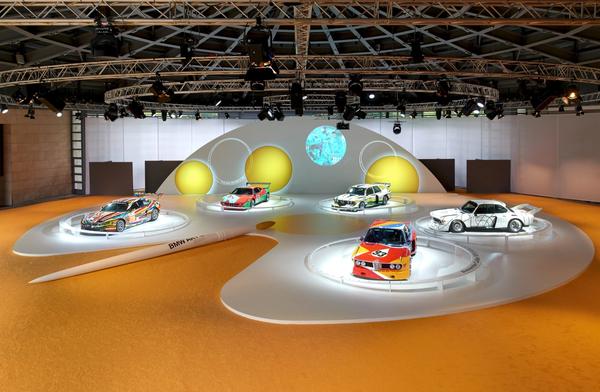Fifty Years of Electric BMWs

BMW has been building electric cars, in limited numbers, since 1972. The production of full electrics is about to ramp up in a big way. Let’s look at the history.
BMW 1602 Electric (1972)
Starting in 1969, BMW constructed two experimental vehicles on the basis of the BMW 02 Series with the aim of investigating the suitability of an electric drive unit for practical driving. The place of the manual gearbox was taken by a DC shunt-wound motor with a peak output of 32 kW that had been developed by Bosch and whose power was directed to the rear wheels via the intermediate gearing and prop shaft. A thermostat-controlled 140W radial fan took care of cooling. The 85-kilogram electric motor drew its power from 12 standard 12V lead-acid batteries from Varta, which were positioned on a pallet in the engine bay. The battery pack weighed in at a hefty 350 kilograms, although it could be removed as a single unit and replaced with a freshly charged pack. The BMW 1602 Electric was seen as just a first attempt at development rather than a viable solution.
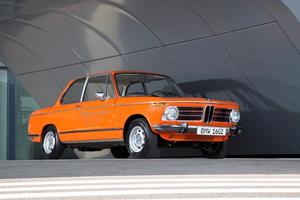 1602 Electric
1602 ElectricBMW 325iX (1987–1990)
The “Electric car with high-energy battery” research project first launched in 1981 eventually led to eight BMW 325iX models being converted from all-wheel to front-wheel drive in 1987. They served as experimental vehicles for trialing a brand-new, maintenance-free sodium-sulphur (NaS) battery, which had been purpose-developed by Asea Brown Boveri (ABB) for use in an electric vehicle. With an energy density three times greater than that of conventional lead-acid batteries it represented a great leap forward. For the first time there was a realistic prospect of mitigating the specific disadvantages of electric drive systems, such as battery weight and the space required. Beyond this, all of the electric drive components were to be tested and further improved. BMW constructed a special test rig for this purpose with a built-in output calculator.
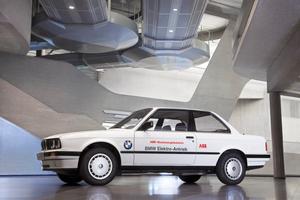 E30 Electric
E30 ElectricBMW E1 and E2 (1991–1993)
Encouraged by the positive results with the new NaS battery, BMW Technik GmbH was commissioned to develop an electric vehicle from scratch, with the objective of investigating the electric drive’s advantages and disadvantages in practical operation. The target specifications included performance suitable for everyday motoring, a reasonable driving range, enough room for four adults plus luggage, and high standards of safety, all while keeping weight to a minimum. After just ten months in development, the result had its public premiere at the 1991 Frankfurt Motor Show as the BMW E1, a city-mobile with a compact exterior and a versatile interior. Even now, 20 years on, many of its technical features still have a sophisticated ring to them.
A second, more advanced version of the BMW E1 was presented at the 1993 Frankfurt Motor Show. It was equipped with a new means of energy storage based on sodium-nickel chloride (NaNiCl2). The “ZEBRA” battery, as it was known, was another significant leap forward, as it helped to improve not just service life, but driving range and performance, too. The drive system in the BMW E1 was furthermore designed so efficiently that the energy generated during vehicle deceleration was automatically fed back into the battery. One year prior to this, BMW had already taken the wraps off the E2 at the Los Angeles Auto Show. Derived from the first-generation BMW E1, this study’s dimensions and power output had been specially adapted to the US market.
 BMW E1
BMW E1BMW 325/BMW Electric (1992–1997)
Starting in the early 1990s, the third generation of the BMW 3 Series provided the basis for some 25 experimental vehicles, which were used for testing and honing new components in order to gradually bring electric drive technology up to production standard. The first generation of these prototype vehicles included eight models that took part in the world’s largest public field trial staged on the German island of Rügen. A further six test vehicles were incorporated into the fleet of the Bavarian State Government. Following problems related to the sodium-sulphur batteries, in 1993 the energy storage devices were switched to the sodium-nickel chloride batteries already familiar from the BMW E1. One BMW 325 model from the Rügen fleet was fitted with a nickel-cadmium (NiCd) battery. Over the course of development, electric motors with outputs of up to 45 kW were used, which now weighed just 65 kilograms including transmission. Notable progress was also made with regard to the energy storage technology, with quick charging now enabling the batteries to attain 75 per cent of capacity in just 40 minutes. Finally, the engineers also succeeded in recuperating as much as 20 per cent of the electrical energy during driving.
 Electric E36 3 Series
Electric E36 3 SeriesMINI E (2008)
When the BMW Group first presented the MINI E in 2008, it brought out a fleet of over 600 purely electrically powered cars designed for private, everyday use. A broad-based pilot project was launched which saw the electric car being supplied to selected private and corporate customers, first in the USA and then in Europe. The evolution of lithium-ion batteries for automotive applications reached a whole new level in the MINI E, with power capabilities, storage capacity and dimensions all making impressive readings. For the first time, customers were provided with a special charging station known as a wall box, which allowed the energy storage devices to be fully recharged in the space of two-and-a-half hours. The performance, range and everyday practicality of the MINI E helped to further boost interest in electric drive concepts and acceptance of them.
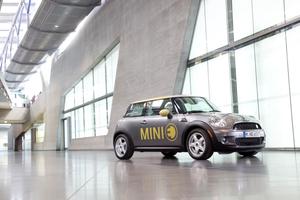 MINI E from 2008
MINI E from 2008BMW ActiveE (2010)
In early 2010, just a year or so after the debut of the MINI E, the BMW Group took another big step towards a zero-emission production vehicle with the world premiere of the BMW Concept ActiveE.The BMW ActiveE was built on the basis of the BMW 1 Series Coupé and allowed BMW to test versions of the drive components and energy storage devices for the future Megacity Vehicle (which became the i3) To this end, a test fleet of over 1,000 models was dispatched into service in 2011.
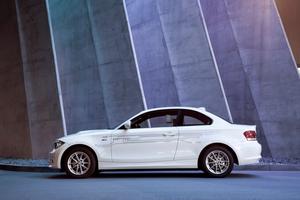 ActiveE, based on the 1 Series
ActiveE, based on the 1 SeriesBMW i3 (since 2013)
The BMW i3 was unveiled in 2013. Offered in both pure electric and range-extender models, the i3 makes extensive use of carbon fiber. Though it was a groundbreaking car, the $50,000 plus purchase price and limited range hindered widespread adoption. Still, over 200,000 have been sold.
 2013 i3
2013 i3BMW i8 (2014-2019)
Introduced with the i3, the i8 was a hybrid gas/electric supercar. With a price in excess of $140,000, it was a limited production car and probably way ahead of its time.
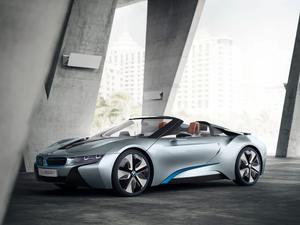 i8 Hybrid
i8 HybridNext Models (2022 and beyond)
BMW’s stated intention is to offer the power of choice in its powertrains, with most new cars offering a choice of gas, diesel (in Europe), hybrid and full-electric. This is an 180 degree change from the i3/i8 approach, where both cars were engineered specifically as electric cars from the ground up. The market will decide if BMW’s new strategy is the right one. The all-new iX, a fully electric SAV, is the first of this new generation of BMWs. It is expected to be available in 2022.
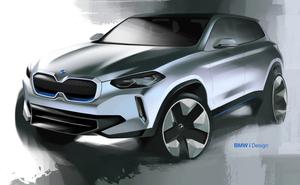 iX3
iX3



